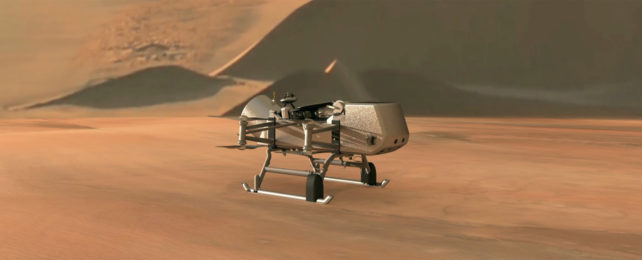Smothered in a hazy atmosphere that hides shallow lakes of liquid hydrocarbons, Titan is one weird world we're dying to look at up close. Which is why NASA is preparing to launch a robotic rotocraft to scope out the scenery in 2027.
We now have a better idea of just what kind of scenery awaits NASA's Dragonfly mission.
Due to arrive on Saturn's largest moon in 2034, the lander will eventually set itself down in the Shangri-la dune field near the Selk crater. Researchers describe it as a "scientifically remarkable area" worthy of exploration, and we still have plenty more to learn about it.
A new study maps six specific parts of the region, identifying it as a place likely to be covered by sand dunes and broken up, icy ground. The work will provide a foundation for models and hypotheses that can be tested by Dragonfly once the probe lands.
"Dragonfly will land in an equatorial, dry region of Titan – a frigid, thick-atmosphere, hydrocarbon world," says planetary scientist Léa Bonnefoy, from Cornell University in New York.
"It rains liquid methane sometimes, but it is more like a desert on Earth – where you have dunes, some little mountains and an impact crater. We're looking closely at the landing site, its structure and surface."
That close look involved a detailed analysis of radar images snapped by the Cassini probe: by looking at the way that radar signals change and reflect from different angles (technically known as their backscatter curves), the researchers were able to make educated guesses about parts of the Titan surface.
As Cassini's images only have a resolution of around 300 meters (984 feet) per pixel, the team also factored in data collected by the Huygens lander, which touched down to the south of the new prospective landing site.
So far many of these details, such as the height and shape of the Selk crater, are little more than estimates, meaning there's plenty of analysis to be done between now and 2034.
"Over the next several years, we are going to see a lot of attention paid to the Selk crater region," says planetary scientist Alex Hayes, from Cornell University.
Dragonfly is going to be what's called a rotorcraft; a helicopter-like contraption that will operate in a similar way to a consumer drone when it reaches the landing zone. It's planned to weigh around 450 kilograms (992 pounds), with eight rotors that are each about a meter (3.3 feet) in diameter.
In Titan's low wind, low gravity atmosphere, Dragonfly will zoom around at a maximum speed of 36 kilometers (22 miles) per hour, building up to longer and longer flights away from its initial landing site.
As Titan is in many ways comparable to the early Earth, scientists are hoping to learn more about our own planet as well as the Saturnian moon. Ultimately our understanding of Titan is expected to grow considerably once Dragonfly arrives, in the same way that the Curiosity rover has shown us so much more about Mars.
"Dragonfly is going to finally show us what the region – and Titan – looks like," says Bonnefoy.
The research has been published in the Planetary Science Journal.
